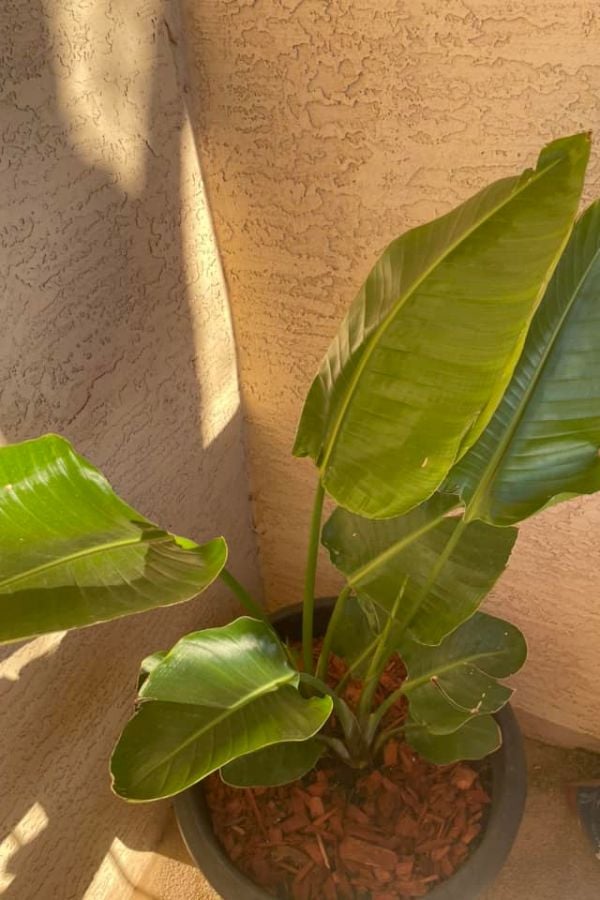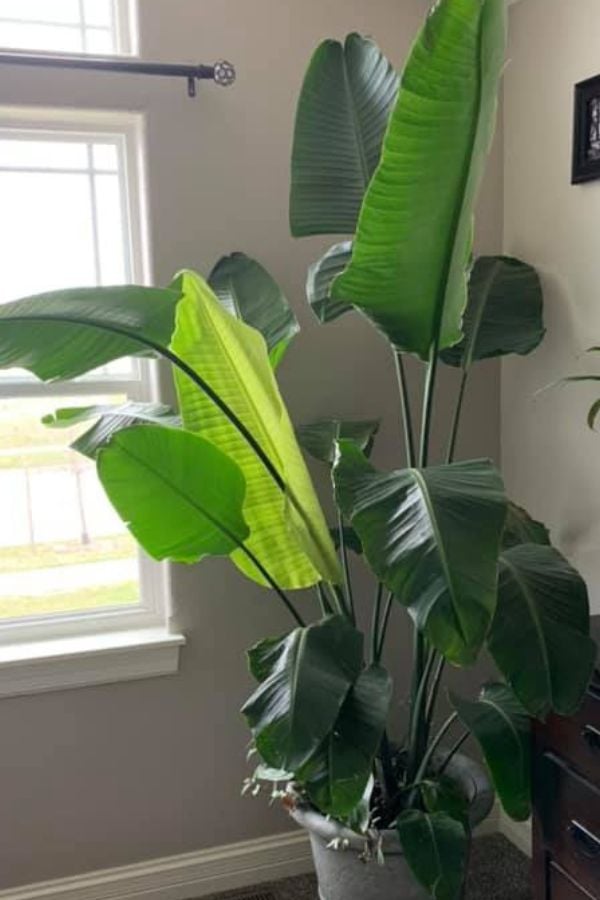The Paradise plant thrives best when it receives a minimum of six hours of bright, direct sunlight each day. This tropical beauty adores basking in the sun’s radiant glow, soaking it up leaf by leaf. More sunlight often translates to a healthier and more vibrant plant since it absolutely loves the sunshine.
Do note, however, that the lack of adequate sunshine will inhibit the plant’s blooming process. Sure, the plant must reach a certain age to bloom, but sunlight (or the lack thereof) can significantly influence the timing and quality of the blooming phase.
When the Paradise plant gets the sunlight it needs, the outcome is impressive. Your plant will grow more robust, brighter, and it’s sure to spread happiness throughout your home.
So, here’s a friendly suggestion. If your home doesn’t provide the necessary six hours of bright sunlight, you might want to reconsider your decision to get a bird of Paradise plant. This plant is sun-loving to its core, and inadequate sunlight could limit its growth and flowering potential.
Contents
Natural Habitat of the Bird of Paradise
This plant is native to sunny regions like Madagascar and South Africa, which explains its love for direct sun and warmth. When growing indoors, aim to maintain an optimal temperature between 68 to 77 °F (20 to 25 °C) in summer and spring.
During summer, I usually place my Bird of Paradise on the balcony to ensure it gets fresh air. But in winter, especially when the plant is dormant, it needs a cooler environment, between 57 to 61 °F (14 to 16 °C) is sufficient.
If your plant is about to bloom, leave it in a warmer place after the winter months. The Bird of Paradise naturally grows along riversides, favoring moist, well-drained soil with an acidity or pH of 6.5.
I recommend blending your potting mix with some compost, perlite, and sand to enhance the soil’s drainage capabilities, fostering a healthier environment for your plant to grow.
As you can see, the Bird of Paradise loves the outdoors, thriving in sunny, humid environments. That’s why in the United States, you’ll often see these plants growing in sun-drenched areas like Hawaii and Florida.
However, the Bird of Paradise can adapt well to indoor environments, provided you can ensure the above-mentioned temperature, humidity, and light requirements. If cared for correctly, this beautiful plant will reward you with its stunning, vibrant blooms.
Cherishing the Sun, But Not the Scorch

Indeed, your Bird of Paradise loves sunlight, but that doesn’t mean it requires constant exposure. As mentioned earlier, your plant thrives best with a minimum of six hours of direct sunlight coupled with bright diffused light.
A balance of these two factors ensures optimum growth and timely blooming. During hot weather or summer conditions, it’s beneficial to place your plant in a shaded area to prevent sunburn on the leaves.
Positioning Your Bird of Paradise

Optimally, your Bird of Paradise should be placed near a south-facing window to get direct sun rays. But what if you only have north-facing windows?
In that case, you’ll need to move your plant around to ensure it gets some sun every day. During summer, you might consider moving your Bird of Paradise outdoors, like to your patio or balcony. To protect it from sunburn, keep it in a shaded or semi-shaded area.
However, when positioning the plant indoors, you need to consider how to maintain the right humidity, especially if your home tends to be dry. A simple solution is to use a humidifier.
This device can replicate the natural humidity that the Bird of Paradise is accustomed to, ensuring the plant stays hydrated and preventing dehydration in the leaves and blooms.
Can Bird of Paradise Grow Indoors or Bedroom Low Light?
I gather you’re referring to those corners of your home that have minimal lighting—where direct sunlight is absent, and the brightness is less than typical indirect outdoor light.
Bird of Paradise, a large-leafed plant, needs substantial energy to maintain its health, and even more when it’s blooming. The plant produces energy through a process called photosynthesis, which is directly related to sunlight.
Sunlight is a key ingredient in photosynthesis; without it, the plant can’t generate sufficient food to support its leaves and other parts.
For clarity, let’s delve into the photosynthesis process. During photosynthesis, the leaves of plants, including the Bird of Paradise, capture sunlight.
This is facilitated by chlorophyll, a component in leaf cells also responsible for their green color. This sunlight fuels the plant and helps convert carbon dioxide absorbed from the air into glucose.
This glucose then transforms into cellulose, the building block of plant cells. Therefore, if photosynthesis is hindered due to low light, the plant won’t produce enough cellulose, ultimately stunting the growth of your Bird of Paradise.
In a low light environment, the plant doesn’t receive enough sunlight to carry out photosynthesis effectively.
As a result, it must conserve its energy, which in turn limits growth. In such conditions, the plant’s primary focus shifts from thriving to mere survival—it channels its energy to just barely stay alive.
Consequently, you’ll likely notice diminished growth and a lack of blooms in your Bird of Paradise when it’s grown in low light conditions.
Is Your Bird of Paradise Lacking Enough Light? Spot the Signs
The only real excuse for your bird of paradise not showing new growth is during winter, as it’s normal for plants to go dormant during this season.
However, if your plant fails to exhibit new growth over an extended period, it could be merely surviving instead of thriving. Such a situation indicates that your bird of paradise needs ample light to generate enough energy for growth.
When your plant doesn’t get enough sunlight, it instinctively enlarges its leaves to absorb the necessary light for growth, instead of focusing on new growth.
Over time, it becomes evident that the plant’s growth doesn’t meet expectations. Consequently, this added strain can cause your plant to lose its vibrant bluish-green hue, making it appear dull.
Another unmistakable sign of inadequate lighting is when you notice that the water in your plant takes longer than usual to evaporate.
This delayed evaporation results from the plant not making enough food, thus using water less efficiently. Also, low light conditions substantially reduce the evaporation rate.
Therefore, even when you’re watering your bird of paradise sufficiently, it can give the impression of overwatering because the water isn’t used as efficiently as it should be. Ultimately, this excess water can lead to root rot, a fatal disease for your bird of paradise.
If the lack of light becomes severe, your plant will not produce enough chlorophyll—the green pigment in leaf cells.
As a result, you’ll start to notice a discoloration of the leaves on your bird of paradise, turning them pale or pale yellow. Other clear indicators of a problem are signs of wilting or drooping.
Signs That Your Bird of Paradise Is Getting Too Much Light
While the bird of paradise thrives in sunlight in the wild, it does best in partial sun or shade when grown as a houseplant.
This is primarily because, as a houseplant, it’s shielded from the storms and varying conditions of the outdoors. However, if you suddenly expose your indoor bird of paradise to full sun, it may suffer leaf scorch or sunburn.
In addition, extreme heat combined with intense sunlight can break down the chlorophyll in leaf cells. Chlorophyll is what gives the plant its lovely bluish-green color.

As a result of this breakdown, you might observe that your plant’s leaves have a faded, sunburnt look, eventually turning to a dull brown color and becoming brittle.
Your bird of paradise leaves may also show burn symptoms if it doesn’t get enough water in combination with exposure to too much sun and heat.
In such situations, your plant will attempt to cool down by using more water, absorbing much of the water from the soil.
Excessive light isn’t only an issue when dealing with natural sunlight. If you use an indoor horticultural grow light, it could also expose your plant to too much light.
Placing the light too close to the plant or leaving it on 24/7, thinking it will help the plant thrive, is a misconception.
Overexposure to light can disrupt the normal physiological cycle of your plant, hinder growth, and fade the leaf color to tan or brown.
Therefore, understanding the light requirements of your bird of paradise is crucial to promote healthy growth and avoid stunting.
Key Takeaways
- The Bird of Paradise thrives best with a minimum of six hours of direct sunlight each day, as insufficient light can stunt growth and impact the blooming phase.
- While the Bird of Paradise loves sunlight, too much exposure, whether natural or from grow lights, can disrupt the plant’s normal cycle and hinder growth, leading to faded or brown leaves.
- For indoor growth, maintaining proper humidity levels is crucial, which can be achieved by using a humidifier, especially in drier environments.
- Signs of a Bird of Paradise getting insufficient light include increased leaf size, dull leaf color, slow water evaporation, and leaf discoloration.






